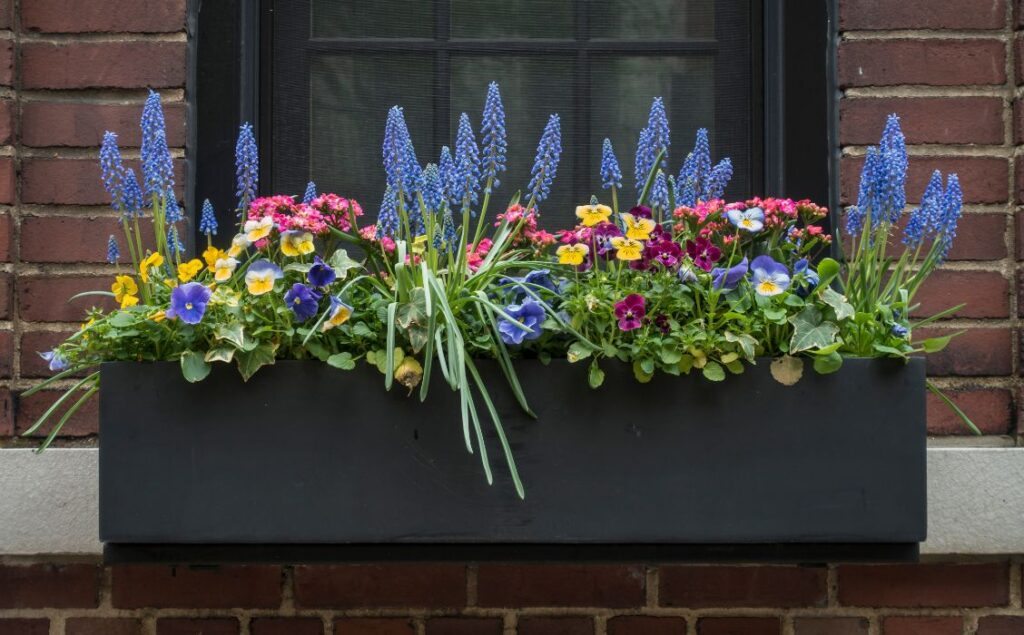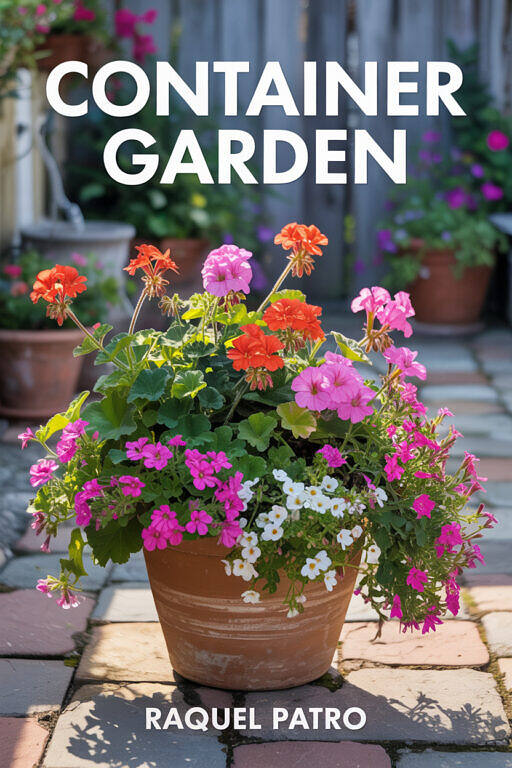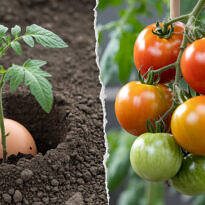Looking for the best plants for window box? Don’t worry—this guide will ignite your imagination with fresh ideas and inspiration for your window box gardens, also known as planters, as many prefer to call them.
A few months ago, I found myself lost in the travel photos my friend Laura shared on Instagram from her recent adventure in Italy. Among images of aromatic pizzas and colorful gelatos that could make anyone’s mouth water, something in particular caught my attention: the windows. But these weren’t just ordinary windows—they were hanging gardens, overflowing with red and pink geraniums cascading from aged window boxes, with lavender and colorful petunias creating a breathtaking visual, as if straight out of a romantic movie about Tuscany or something like that…

At that moment, I promised myself that one day, I would have windows like those (and take a trip to Italy!). The universe has a funny way of granting our wishes—three months later, by one of those life coincidences, I moved into a townhouse that, to my surprise, had three built-in window boxes. They were empty and neglected, it’s true, but they were brimming with possibilities.
My journey to transform these window boxes into hanging gardens began with a lot of research and some trial and error. Today, after two years of experience, I have geraniums that could make Italians jealous, a small herb and medicinal plant garden, and a collection of succulents that often catch the attention and admiration of passersby.
Before You Begin: What You Need to Know
Before diving into the magical world of best plants for a window box, there are a few crucial technical aspects I’ve learned—sometimes the hard way—that can save both your plants and your home from future problems.
Waterproofing: Your Best Friend
Proper waterproofing of your window box isn’t just a recommendation—it’s an absolute necessity. A poorly waterproofed box can cause leaks that compromise your home’s structure and create unsightly stains on your walls. I recommend using specialized waterproofing products and renewing the treatment every two years. Various materials are available on the market, including asphalt-based, epoxy, and rubberized coatings. Choose a product that can withstand constant moisture.
Drainage: The Secret to Healthy Plants
Just as important as selecting the best plants for your window box is ensuring that water doesn’t stagnate. An efficient drainage system prevents:
- Root rot;
- Fungal growth;
- Plant death due to overwatering.
The ideal solution is:
- Having good drainage holes;
- Adding stones or expanded clay at the base;
- Using geotextile or geocomposite fabric to separate layers and prevent soil from blocking drainage;
- Selecting a high-quality potting mix that allows good aeration.

Sun Exposure: Each Orientation Tells a Story
Before selecting the best plants for your window box, carefully observe the sunlight exposure of each window:
- In the Southern Hemisphere: East-facing boxes receive soft morning sun—perfect for most partial-shade flowers. West- or north-facing boxes require more sun-resistant plants, as they endure the intense afternoon sun. South-facing boxes will be cooler and shadier, ideal for shade-loving species.
- In the Northern Hemisphere: Similarly, east-facing boxes get gentle morning sunlight. West- or south-facing ones need heat- and sun-tolerant plants, while north-facing boxes will be cooler and darker, suited for shade plants. This analysis is crucial when selecting the most suitable species for each window box.
Challenges of Growing at Height: Wind and Temperature
Even if you choose the best plants for your window box, growing them in these conditions presents unique challenges not typically found in traditional gardens. Wind, for example, is a major factor—the higher the floor, the stronger the gusts. Window box plants should have sturdy stems and leaves or a compact growth habit to withstand the wind. In some cases, only plants adapted to such harsh conditions, such as sclerophyllous species (hard-leaved plants like rosemary and lavender) or xerophytes (drought-adapted plants like succulents and cacti), will thrive.
Watering and Moisture Retention: A Delicate Balance
Constant exposure to wind and sun significantly accelerates water evaporation in window boxes. During summer, your plants may need watering twice a day. Additionally, the materials used in your window boxes can drastically affect soil temperature. Concrete or masonry boxes tend to retain more heat than those made of wood or fiber, creating a greenhouse effect for the roots. To minimize this impact:
- Install an automatic irrigation system with a timer (many companies specialize in this service).
- Use water-retaining gel in the soil, along with moisture-holding materials like peat, charcoal, coconut fiber, perlite, and vermiculite.
- Apply mulching to reduce evaporation.
- Paint dark-colored boxes with light colors to reflect heat.
- Use an insulating inner lining.
- Opt for deeper window boxes, which provide better root protection.
Now that we’ve covered the essential technical aspects, we can move on to the selection of the **55 best plants** that will transform your windows into stunning hanging gardens. Each species has been carefully chosen based on adaptability, beauty, utility, and ease of maintenance.
The 55 Best Plants for Window Boxes
1. Geranium (Pelargonium x hortorum)
The classic choice for European window boxes, featuring abundant flowers in shades of red, pink, and white that bloom nearly year-round with proper care.
- Function: Filler and vertical element
- Light: Full sun
- Watering: Moderate, allowing soil to dry slightly between watering
- Fertilization: Monthly during flowering
- Lifespan: Perennial
- Tolerance: Highly resistant to heat and wind; can survive light frost if protected
2. Trailing Geranium (Pelargonium peltatum)
Yes! There are two types of geraniums, and you can combine them. Trailing geraniums are ideal for window boxes and planters. They are responsible for the stunning cascades of flowers on the windows of Tuscany that my friend showed me.
- Function: Trailing plant
- Light: Full sun
- Watering: Moderate, allow soil to dry slightly between watering
- Fertilization: Monthly during blooming season
- Lifespan: Perennial
- Tolerance: Heat and wind resistant; can survive light frosts
3. Petunia (Petunia x hybrida)
Petunias produce abundant flowers in various colors, ideal for creating colorful cascades in window boxes during spring and summer.
- Function: Trailing and filler plant
- Light: Full sun
- Watering: Regular, keep soil consistently moist
- Fertilization: Biweekly during blooming season
- Lifespan: Annual
- Tolerance: Good heat resistance; sensitive to frost
4. Lavender (Lavandula spp.)
Beyond its beautiful purple flowers, lavender offers a delightful aroma and attracts beneficial pollinators.
- Function: Vertical element
- Light: Full sun
- Watering: Low, tolerates dry periods
- Fertilization: Quarterly
- Lifespan: Perennial
- Tolerance: Excellent resistance to wind, heat, and cold
5. False Heather (Cuphea hyssopifolia)
Delicate, small flowers that bloom abundantly, creating a “cloud-like” colorful effect.
- Function: Filler plant
- Light: Full sun to partial shade
- Watering: Moderate
- Fertilization: Monthly
- Lifespan: Perennial
- Tolerance: Good heat and moderate wind resistance
6. Calibrachoa ‘Million Bells’ (Calibrachoa x hybrida)
Similar to mini petunias, this plant produces an abundance of vibrant flowers.
- Function: Trailing plant
- Light: Full sun
- Watering: Regular, keep soil consistently moist
- Fertilization: Biweekly during blooming season
- Lifespan: Short-lived perennial
- Tolerance: Heat-resistant; sensitive to intense cold
7. Verbena (Verbena x hybrida)
Delicate clustered flowers in bright colors, excellent for adding volume and color.
- Function: Trailing and filler plant
- Light: Full sun
- Watering: Moderate
- Fertilization: Monthly
- Lifespan: Perennial
- Tolerance: Good heat and wind resistance
8. Pansy (Viola x wittrockiana)
Ideal for cooler seasons, these charming flowers come in various colors.
- Function: Filler plant
- Light: Full sun in winter, partial shade in summer
- Watering: Regular
- Fertilization: Monthly
- Lifespan: Annual
- Tolerance: Excellent cold resistance; sensitive to intense heat
9. Lobelia (Lobelia erinus)
Small, intensely blue flowers that create stunning cascades.
- Function: Trailing plant
- Light: Full sun to partial shade
- Watering: Regular, does not tolerate dry soil
- Fertilization: Biweekly
- Lifespan: Annual
- Tolerance: Prefers mild climates; sensitive to extreme heat
10. Snapdragon (Antirrhinum majus)
Tall, colorful flowers that add height and drama to your window box composition.
- Function: Vertical element
- Light: Full sun
- Watering: Moderate
- Fertilization: Monthly
- Lifespan: Annual
- Tolerance: Good cold resistance; moderate heat tolerance
11. Basil (Ocimum basilicum)
Besides being decorative, it offers aromatic leaves for culinary use.
- Function: Vertical element and filler
- Light: Full sun
- Watering: Regular
- Fertilization: Monthly
- Lifespan: Annual
- Tolerance: Good heat resistance; sensitive to cold
12. Ornamental Sweet Potato (Ipomoea batatas)
Vibrant foliage in shades of green, purple, or variegated patterns, creating lush cascades.
- Function: Trailing and filler plant
- Light: Full sun to partial shade
- Watering: Moderate
- Fertilization: Monthly
- Lifespan: Perennial
- Tolerance: High heat resistance; sensitive to frost
13. Fan Flower (Scaevola aemula)
Lilac flowers resembling small hands, with a contrasting center.
- Function: Filler and trailing plant
- Light: Partial shade
- Watering: Moderate
- Fertilization: Monthly during blooming season
- Lifespan: Perennial
- Tolerance: Good resistance to wind and moderate heat
14. Fuchsia (Fuchsia x hybrida)
Delicate, ballerina-like hanging flowers in shades of pink, purple, and white.
- Function: Trailing plant
- Light: Partial shade
- Watering: Regular, keep soil consistently moist
- Fertilization: Biweekly during blooming season
- Lifespan: Perennial
- Tolerance: Prefers mild climates; sensitive to intense heat
15. Ivy (Hedera helix)
A classic evergreen foliage plant that creates elegant cascades and can cover the entire window box.
- Function: Trailing plant
- Light: Partial shade to full shade
- Watering: Moderate
- Fertilization: Quarterly
- Lifespan: Perennial
- Tolerance: High resistance to cold and wind; tolerates heat with some protection
16. Dichondra (Dichondra argentea ‘Silver Falls’)
A silver-leaved foliage plant that creates delicate, shimmering cascades.
- Function: Trailing plant
- Light: Full sun to partial shade
- Watering: Low to moderate
- Fertilization: Monthly
- Lifespan: Perennial
- Tolerance: Excellent heat and drought resistance
17. Coral Bell (Heuchera spp)
An ornamental foliage plant available in various shades, from green to deep purple, with delicate flowers.
- Function: Filler plant
- Light: Partial shade
- Watering: Moderate
- Fertilization: Quarterly
- Lifespan: Perennial
- Tolerance: Good cold resistance; needs protection from intense heat
18. Globe Amaranth (Gomphrena globosa)
Round, colorful flowers that retain their color even after drying.
- Function: Vertical element
- Light: Full sun
- Watering: Moderate
- Fertilization: Monthly
- Lifespan: Annual
- Tolerance: High resistance to heat and wind
19. Calendula (Calendula officinalis)
Edible flowers in shades of orange and yellow, with medicinal properties.
- Function: Filler plant
- Light: Full sun
- Watering: Moderate
- Fertilization: Monthly
- Lifespan: Annual
- Tolerance: Good cold resistance; sensitive to extreme heat
20. Impatiens (Impatiens walleriana)
Abundant flowers, ideal for shaded window boxes.
- Function: Filler plant
- Light: Shade to partial shade, or full sun for “Sunpatiens” varieties
- Watering: Regular, keep soil consistently moist
- Fertilization: Biweekly during blooming season
- Lifespan: Perennial but often grown as an annual
- Tolerance: Sensitive to intense heat and strong winds
21. Lantana (Lantana camara)
One of the best plants for window boxes, Lantana produces multicolored flowers that attract butterflies and change color as they mature.
- Function: Filler with trailing potential
- Light: Full sun
- Watering: Moderate
- Fertilization: Monthly
- Lifespan: Perennial
- Tolerance: Excellent resistance to heat and wind
22. Trailing Vinca (Vinca major variegata)
Variegated green and white foliage with delicate blue flowers, excellent for cascading effects.
- Function: Trailing plant
- Light: Partial shade to full sun
- Watering: Moderate
- Fertilization: Quarterly
- Lifespan: Perennial
- Tolerance: High resistance to heat and drought; tolerates moderate cold
Coleus (Plectranthus scutellarioides)
Ornamental foliage with vibrant patterns and colors ranging from purples to oranges.
- Function: Filler and vertical element
- Light: Partial shade
- Watering: Regular, keep soil consistently moist
- Fertilization: Monthly
- Lifespan: Perennial
- Tolerance: Sensitive to cold; needs protection from direct sun
24. Wax Begonia (Begonia semperflorens)
Delicate, abundant flowers in shades of pink, red, and white.
- Function: Filler
- Light: Partial shade
- Watering: Regular
- Fertilization: Biweekly during blooming season
- Lifespan: Perennial but often grown as an annual
- Tolerance: Sensitive to strong winds; prefers mild climates
25. Zinnia (Zinnia elegans)
Colorful, long-lasting flowers, excellent for attracting butterflies.
- Function: Vertical element
- Light: Full sun
- Watering: Moderate
- Fertilization: Monthly
- Lifespan: Annual
- Tolerance: High heat resistance; sensitive to cold
26. Creeping Jenny (Lysimachia procumbens)
Round, glossy leaves, with a special highlight for the golden variegated foliage.
- Function: Trailing and filler plant
- Light: Full sun to partial shade
- Watering: Regular
- Fertilization: Monthly
- Lifespan: Perennial
- Tolerance: Good cold resistance; needs protection from intense heat
27. Bacopa (Chaenostoma cordatum)
Small white or blue flowers that form a delicate floral carpet.
- Function: Trailing plant
- Light: Full sun to partial shade
- Watering: Regular, does not tolerate dry soil
- Fertilization: Biweekly
- Lifespan: Perennial
- Tolerance: Prefers mild climates; sensitive to extreme heat
28. Foxtail Fern (Asparagus densiflorus)
Delicate, feathery foliage that creates a soft and textured effect.
- Function: Trailing and filler plant
- Light: Partial shade
- Watering: Moderate
- Fertilization: Quarterly
- Lifespan: Perennial
- Tolerance: Good heat and moderate wind resistance
29. Oregano (Origanum vulgare)
Aromatic herb that also produces delicate flowers attractive to bees.
- Function: Trailing and filler plant
- Light: Full sun
- Watering: Low to moderate
- Fertilization: Monthly
- Lifespan: Perennial
- Tolerance: High heat and drought resistance
30. Thyme (Thymus vulgaris)
A compact, aromatic herb with small lilac flowers. Some variegated cultivars are highly ornamental.
- Function: Filler plant
- Light: Full sun
- Watering: Low
- Fertilization: Quarterly
- Lifespan: Perennial
- Tolerance: High heat and cold resistance; tolerates wind
31. Trailing Verbena (Glandularia tenera)
Delicate flowers in shades of purple and pink, forming a floral carpet.
- Function: Trailing and filler plant
- Light: Full sun
- Watering: Moderate
- Fertilization: Monthly during blooming
- Lifespan: Perennial
- Tolerance: Good heat and wind resistance
32. Spearmint (Mentha spicata)
A vigorous, fast-spreading aromatic herb, ideal for culinary use. Can take over the planter.
- Function: Filler plant
- Light: Full sun to partial shade
- Watering: Regular, keep soil consistently moist
- Fertilization: Monthly
- Lifespan: Perennial
- Tolerance: Highly adaptable; requires growth control
33. Strawberry (Fragaria x ananassa)
In addition to sweet fruit, it produces delicate white flowers and decorative foliage.
- Function: Trailing and filler plant
- Light: Full sun
- Watering: Regular
- Fertilization: Biweekly during fruiting
- Lifespan: Perennial
- Tolerance: Good cold resistance; protect from intense heat
34. Sweet Alyssum (Lobularia maritima)
A carpet of tiny white or lilac flowers with a honey fragrance.
- Function: Filler and trailing plant
- Light: Full sun
- Watering: Moderate
- Fertilization: Monthly
- Lifespan: Annual
- Tolerance: Good cold resistance; tolerates moderate heat
35. Cherry Tomato (Solanum lycopersicum var. cerasiforme)
A productive plant that adds edible interest to the window box.
- Function: Vertical element
- Light: Full sun
- Watering: Regular
- Fertilization: Biweekly
- Lifespan: Annual
- Tolerance: Sensitive to cold; requires staking
36. Creeping Jenny ‘Golden’ (Lysimachia nummularia)
Low-growing, lemon-gold foliage that creates bright cascades.
- Function: Trailing plant
- Light: Full sun to partial shade
- Watering: Regular
- Fertilization: Monthly
- Lifespan: Perennial
- Tolerance: Cold-resistant; requires control due to vigorous growth
37. Nasturtium (Tropaeolum majus)
Edible flowers in warm tones and decorative round foliage.
- Function: Trailing and filler plant
- Light: Full sun
- Watering: Moderate
- Fertilization: Monthly
- Lifespan: Annual
- Tolerance: Good heat resistance; sensitive to cold
38. Moss Rose (Portulaca grandiflora)
Colorful flowers that open with the sun, ideal for hot locations.
- Function: Filler plant
- Light: Full sun
- Watering: Low
- Fertilization: Monthly
- Lifespan: Annual
- Tolerance: Excellent heat and drought resistance
39. Spider Plant (Chlorophytum comosum)
Green and white ribbon-like foliage that naturally produces offshoots.
- Function: Trailing plant
- Light: Partial shade to filtered sun
- Watering: Moderate
- Fertilization: Quarterly
- Lifespan: Perennial
- Tolerance: Adaptable; sensitive to extreme cold
40. Cockscomb (Celosia argentea)
Plumed or crested inflorescences in vibrant colors.
- Function: Vertical element
- Light: Full sun
- Watering: Moderate
- Fertilization: Biweekly during blooming
- Lifespan: Annual
- Tolerance: Good heat resistance; sensitive to cold
41. Madagascar Periwinkle (Catharanthus roseus)
Delicate flowers in shades of pink, white, or lilac, highly resistant.
- Function: Vertical element
- Light: Full sun
- Watering: Moderate
- Fertilization: Monthly
- Lifespan: Perennial but often grown as an annual
- Tolerance: Excellent heat and drought resistance
42. Seemannia (Seemannia sylvatica)
Red or pink tubular flowers, attractive to hummingbirds.
- Function: Filler plant
- Light: Partial shade
- Watering: Regular
- Fertilization: Biweekly during blooming
- Lifespan: Perennial
- Tolerance: Prefers mild climates; protect from direct sun
43. Purslane (Portulaca oleracea)
Delicate, colorful flowers with succulent, edible foliage. A highly ornamental wild edible plant.
- Function: Trailing and filler plant
- Light: Full sun
- Watering: Low
- Fertilization: Quarterly
- Lifespan: Perennial
- Tolerance: Prefers tropical heat; does not tolerate extreme cold
44. Baby Sun Rose (Aptenia cordifolia)
Dense, vibrant green foliage, edible, with small tufted pink flowers.
- Function: Filler and trailing plant
- Light: Full sun
- Watering: Low
- Fertilization: Quarterly
- Lifespan: Perennial
- Tolerance: Tolerates moderate heat and subtropical cold
45. Angelonia (Angelonia angustifolia)
A winter annual with charming flowers in various colors and vertical appeal.
- Function: Vertical element
- Light: Full sun in winter, partial shade in summer
- Watering: Regular
- Fertilization: Monthly
- Lifespan: Annual
- Tolerance: Excellent cold resistance; sensitive to intense heat
46. Grape Hyacinth (Muscari armeniacum)
Tiny blue flowers in a grape-like cluster, perfect for springtime window boxes.
- Function: Low vertical element
- Light: Full sun to partial shade
- Watering: Moderate during blooming, reduced afterward
- Fertilization: At planting and post-blooming
- Lifespan: Perennial bulb
- Tolerance: Excellent cold resistance; goes dormant in summer
47. Lilyturf (Liriope muscari)
Tufted foliage with purple flower spikes, ideal for window box borders.
- Function: Low vertical element
- Light: Partial shade to full sun
- Watering: Moderate
- Fertilization: Quarterly
- Lifespan: Perennial
- Tolerance: High resistance to both cold and heat
48. Scarlet Sage (Salvia splendens)
Bright red flower spikes, a classic choice for window boxes.
- Function: Vertical element
- Light: Full sun
- Watering: Regular
- Fertilization: Monthly during blooming
- Lifespan: Perennial but often grown as an annual
- Tolerance: Good heat resistance; sensitive to cold
49. Boston Fern (Nephrolepis exaltata)
Delicate fronds that create a soft, tropical effect in window boxes.
- Function: Filler and trailing plant
- Light: Partial shade
- Watering: Regular, keep humidity levels high
- Fertilization: Bimonthly
- Lifespan: Perennial
- Tolerance: Sensitive to wind and direct sun
50. Heather (Calluna vulgaris)
Small flowers in shades of pink, purple, or white, ideal for window boxes in cold climates.
- Function: Filler plant
- Light: Full sun
- Watering: Moderate
- Fertilization: Quarterly
- Lifespan: Perennial
- Tolerance: Excellent cold resistance; sensitive to heat
51. Flaming Katy (Kalanchoe blossfeldiana)
Long-lasting flowers in vibrant colors, a succulent ideal for sunny window boxes.
- Function: Filler plant
- Light: Full sun
- Watering: Low
- Fertilization: Monthly during blooming
- Lifespan: Perennial
- Tolerance: High heat and drought resistance
52. String of Hearts (Ceropegia woodii)
Trailing foliage with heart-shaped leaves, ideal for hanging window boxes.
- Function: Trailing plant
- Light: Partial shade
- Watering: Moderate
- Fertilization: Quarterly
- Lifespan: Perennial
- Tolerance: Sensitive to cold; tolerates moderate heat
53. Dipladenia (Mandevilla splendens)
A climbing plant with showy flowers, adaptable for window boxes with support (trellis or railing), ideal for adding privacy.
- Function: Vertical element/climber
- Light: Full sun
- Watering: Regular
- Fertilization: Biweekly during blooming
- Lifespan: Perennial
- Tolerance: Good heat resistance; protect from cold
54. Clematis (Clematis spp.)
An elegant climbing plant with large flowers, excellent for deep window boxes.
- Function: Vertical element/climber
- Light: Full sun with shaded roots
- Watering: Regular
- Fertilization: Monthly during growth
- Lifespan: Perennial
- Tolerance: Varieties available for different climates
55. Marigold (Tagetes patula)
Bright yellow and orange flowers, essential for colorful window boxes.
- Function: Filler plant
- Light: Full sun
- Watering: Moderate
- Fertilization: Monthly
- Lifespan: Annual
- Tolerance: High heat resistance; repels insects
How to Care for Your Window Box Garden
Have you chosen the best plants for your window box? It’s not easy, is it? With so many beauties to choose from…
But remember, maintaining your window boxes is essential to keeping your plants healthy, blooming, and lush throughout the year. One of the most important practices is fertilization, which should be adjusted based on the type of plant you are growing. For annuals and demanding species like petunias and begonias, it’s recommended to use a balanced liquid fertilizer specifically for flowering, diluted in the watering every 15 days to ensure vigorous growth and continuous blooming. For perennials like lavender and ivy, a slow-release fertilizer, such as Osmocote, applied every three to four months, provides a steady supply of nutrients without the need for frequent feeding.
In addition to proper nutrition, maintaining your window box also involves replanting and renewing the soil. Over time, the soil loses nutrients and can become compacted, making it harder for roots to grow. To keep your plants thriving, it’s recommended to refresh your window box every one or two years, removing the old soil and replacing it with a new, nutrient-rich mix. Take this opportunity to check the waterproofing and reapply if necessary.

This is also a great time to reorganize the plants, ensuring proper spacing to prevent competition for light and nutrients. Compact species can be planted about 4-6 inches (10-15 cm) apart, while more vigorous plants should have at least 8 inches (20 cm) of spacing.
Regular pruning and pinching are key techniques for keeping plants well-shaped and encouraging abundant blooming. Pinching is an initial pruning technique used on newly planted seedlings, where the tips of young shoots are removed by hand or with pruning shears. This promotes lateral branching, making the plants denser and fuller. Regular deadheading—removing spent blooms—and cleaning up dry leaves help prevent disease and keep your window box looking its best. Some species, like geraniums, benefit from heavier pruning at the end of their growing season to encourage healthy new growth. With these ongoing care practices, your window box can remain a vibrant display of colors and textures all year round.
Design Tips for Window Boxes
Beauty goes beyond just selecting the best plants for your window box—it’s about how they complement each other to create a harmonious composition. Here are some essential window box landscaping principles you can follow:
The Rule of Three
To create visually appealing arrangements, use:
- A dramatic vertical element, typically one or more upright plants placed at the center or back, serving as a focal point.
- Filler plants, which create cohesion in your window box, uniting different elements into a harmonious display.
- Trailing plants, which cascade over the edges, adding charm and depth.
Just because it’s a window box doesn’t mean you can’t think about landscaping. Consider not just the flowers, but also how their colors work together and complement the color of your house. Pay attention to different shades of green in the foliage instead of focusing solely on blooms. You can also play with the texture of leaves—some may be large or small, fuzzy or smooth, with varying shapes.
Rhythm and repetition are also important, both within the window box and across multiple boxes on different windows. Keep a unifying element throughout the boxes, vary compositions slightly, create a visual flow that guides the eye, and consider the appearance of your entire façade.
For a professional look:
- Ensure each plant has enough space to grow
- Plan with the mature size of each species in mind
- Keep a balanced proportion between the window box and the window
- Leave room for maintenance and pruning
Turning your window into a mini garden has never been this inspiring, right?
One valuable lesson I’ve learned along the way: it’s best to start with a few plants and expand gradually as you learn about their needs and behaviors. Each window has its own personality, and part of the fun is discovering which combinations work best in each space.
Remember, a window box garden is a living, dynamic ecosystem. Some plants might not adapt well, while others might surprise you with their lush growth. Be open to adjustments and changes over time.
With dedication and proper care, your window boxes can transform into stunning hanging gardens, bringing color, life, and nature into your home—whether you live in a city apartment or a house with multiple windows. And who knows? Maybe your window boxes will inspire passersby, just like those Italian windows inspired me years ago.
With these tips on the best plants for a window box, you can create a breathtaking display full of color, fragrance, and vibrancy. Whether you want a romantic look with geraniums and petunias, an elegant touch with ivy and angelonia, or even a mini herb garden with fresh seasonings and strawberries within arm’s reach, the possibilities are endless. Now it’s your turn! Choose your favorite plants, set up your window box, and start growing your own unique and beautiful space today.
Your home—and even your street—will thank you for this transformation!






























































